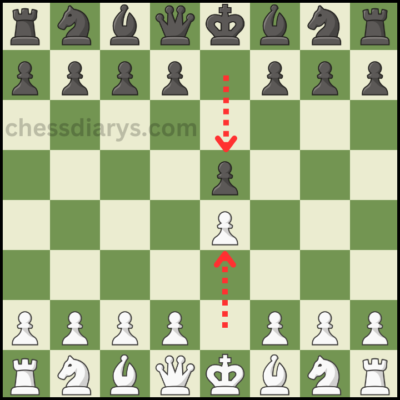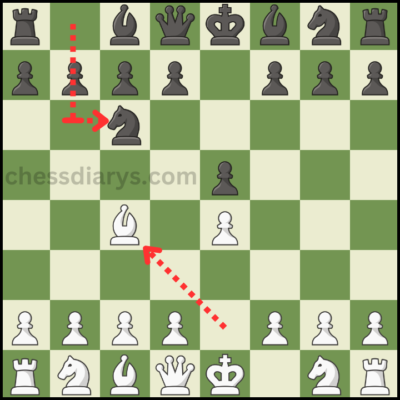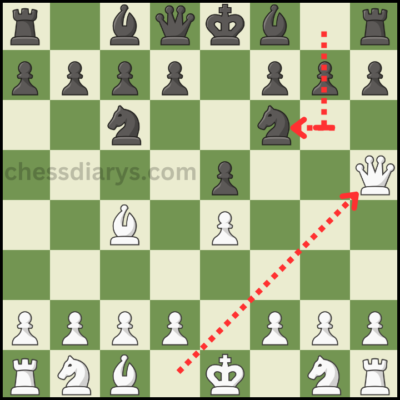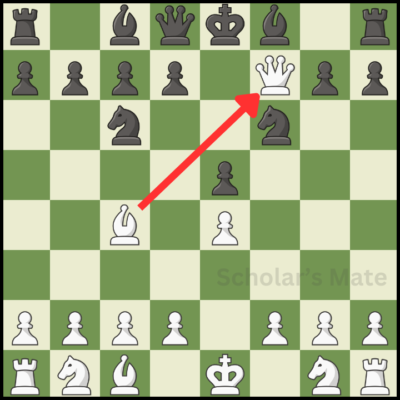Scholars Mate is a well known tactic and one of the most popular ways for beginners to learn how to win chess in 4 moves. In this strategy, the f7 square in Black and the f2 square in White are concerned, since they are the weakest points at the early stage of the game. Therefore, with pressure on one of these squares, you will receive a quick checkmate. This article will walk you through, step by step, both how to perform the Scholar’s Mate and how to defend against it.
What is Scholar’s Mate?
The Scholars Mate is one of the fastest checkmates that can be made in chess. Being a rather simple opening trap that novices usually go with, it can be done within 4 moves provided the opponent fails to defend well. Success with this tactic depends on the ability to apply pressure on the f7 or f2 square with the queen and bishop.
How to Win Chess in 4 Moves
What follows is a step by step breakdown of how to execute the Scholars Mate when playing as White.
Move 1: e4 – Control the Center
Your move should be e4. Moving the king’s pawn two steps forward to e4 helps in staking a claim over the center. It is one of the standard opening moves that gives quick development for your queen and your bishop.

Move 2: Bc4 – Attack f7
Now develop your bishop to c4. This also puts more pressure on the f7 square. Your bishop and queen are working in concert to exploit this weak point, which constitutes a direct threat to checkmate.

Move 3: Qh5 – Develop Your Queen
Next, develop your queen to h5. This move puts direct pressure on the f7 square, the weakest point in Black’s defense early in the game. Although the early development of the queen can be risky, in this position, it is necessary for the Scholar’s Mate tactic.

Move 4: Qxf7– Checkmate
If Black does not pay proper attention to the f7 square, you can checkmate them in the fourth move with Qxf7. There will be no safe squares for the Black king to move into, and no other pieces to interpose and save the king or capture your queen. The game is over with a quick win for White.

Common Mistakes That Allow Scholar’s Mate
Beginner players often make several mistakes that allow the Scholar’s Mate to work. Here are a few errors to watch for:
Neglecting the f7 Square: Most new players focus on developing pieces or controlling the center and forget about defending their king’s most vulnerable square—f7. If f7 is left undefended, it becomes an easy target for White’s queen and bishop.
Overextending the Queen: This is possibly the temptation of early exposure in a most aggressive manner, which may later on prove counterproductive due to lack of proper support. The queen might get subjected to a series of counterattacks and have to retreat if Black
How to Defend Against Scholar’s Mate
As Black, defending against the Scholar’s Mate is pretty easy if you recognize the threat early. Here are two main moves that can defuse the attack:
Move 2: g6 – Block the Queen
To this, after White plays the queen to h5, you respond by playing your pawn to g6. This immediately cuts off the queen’s line of sight towards the f7 square and forces her to retreat. Now you are free to continue your development without any fear of an early checkmate.
3rd Move: Nf6 – Knight Defense
Another good defense is to develop your knight to f6. By doing this, you are not only defending the f7 square but also getting ready for counterattack by threatening the White queen. With this, the protection of the f7 square allows you to start working on developing a strong position.
Why Scholar’s Mate is Less Effective against Experienced Players
While the Scholar’s Mate works wonders against beginners, more experienced players are more often than not aware of this trap and can thus ward off any such attacks comfortably. The drawback with this type of strategy is that you tend to bring out the queen too early into the game, which in itself delays your development and makes the queen susceptible to various different types of attacks.
These are valuable lessons in chess tactics, for example-attacking weak squares and putting pressure on your opponent early, but learning how to play the Scholar’s Mate does teach you those things.
Conclusion:
Knowing how to win chess in 4 moves with the help of the Scholar’s Mate can provide you with a real quick edge in games against inexperienced opponents. Controlling the center, early development of your queen and bishop, and pressuring the weak f7 or f2 square-all these combine to deliver a checkmate in just a few moves. But in chess, as you get better, you should learn more about different tactics and how to study to avoid such opening traps.
Learning the fundamentals of early-game checkmates will get you on your road to becoming a better chess player!
FAQ: Scholar’s Mate in Chess
What is Scholar’s Mate?
Scholar’s Mate is one of the fastest checkmates in chess, typically achieved in just four moves. It targets the weakest squares in the opponent’s position (f7 for Black and f2 for White) using the queen and bishop. It’s a popular tactic among beginners but is less effective against experienced players.
Why is Scholar’s Mate less effective against experienced players?
Experienced players are familiar with this tactic and know how to defend against it. Additionally, bringing the queen out too early can delay development and make it vulnerable to attacks, which skilled players can exploit.
Is Scholar’s Mate a good strategy for beginners?
While Scholar’s Mate can be effective against other beginners, it’s not a reliable long-term strategy. It’s better to focus on fundamental principles like controlling the center, developing pieces, and ensuring king safety.
Can Scholar’s Mate be used in advanced games?
Scholar’s Mate is rarely effective in advanced games because experienced players are well-prepared to defend against it. However, understanding the concept of attacking weak squares and coordinating pieces is valuable for more complex tactics.








